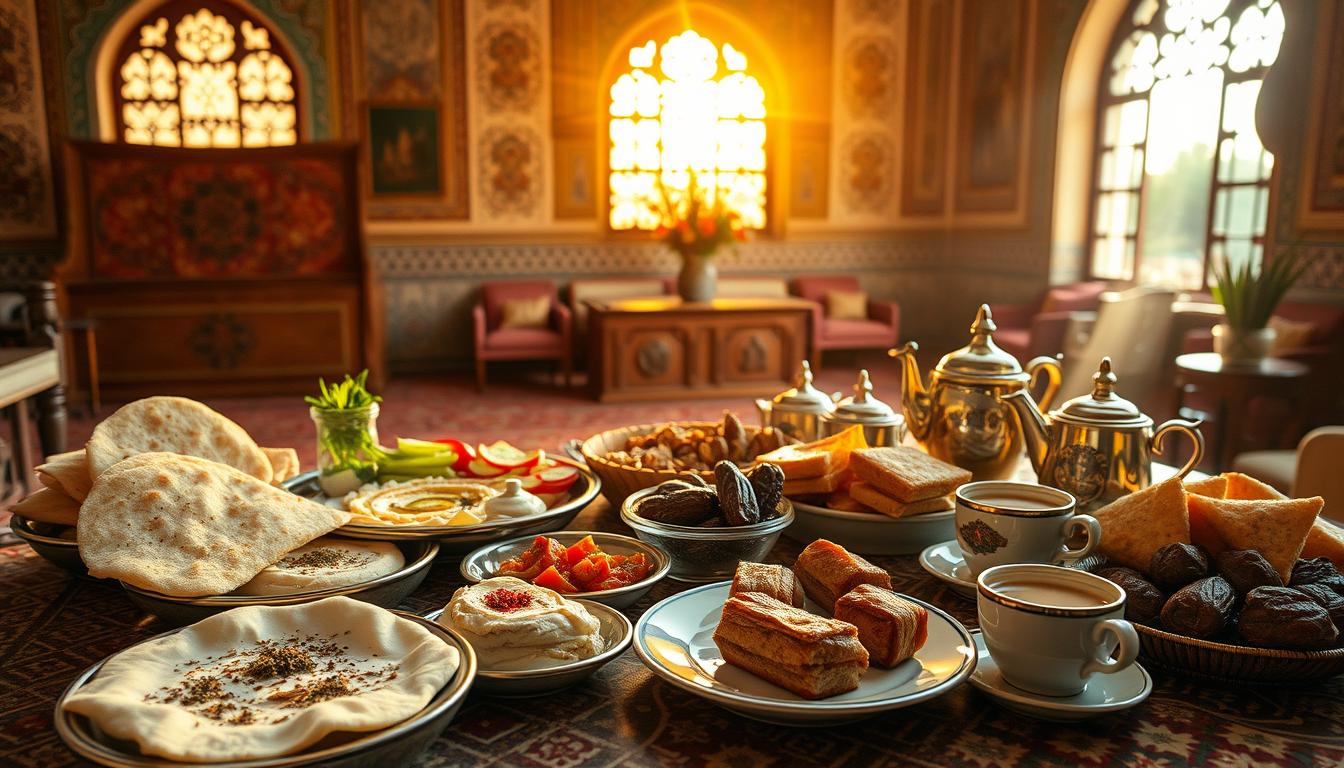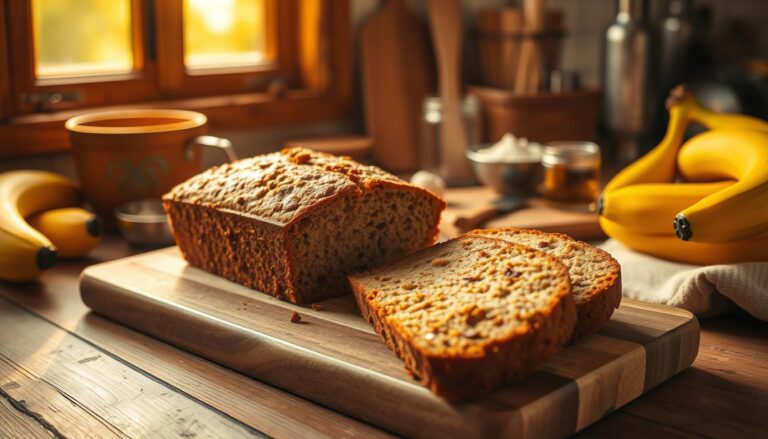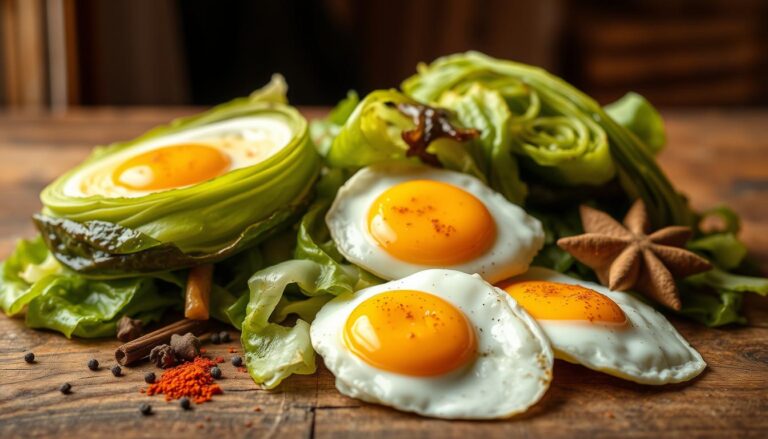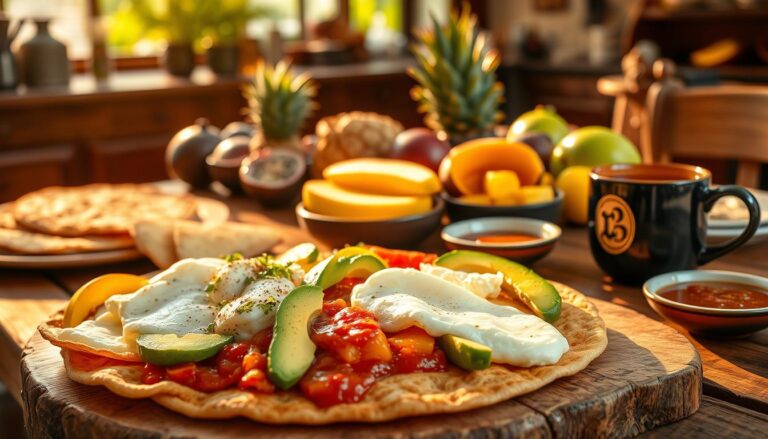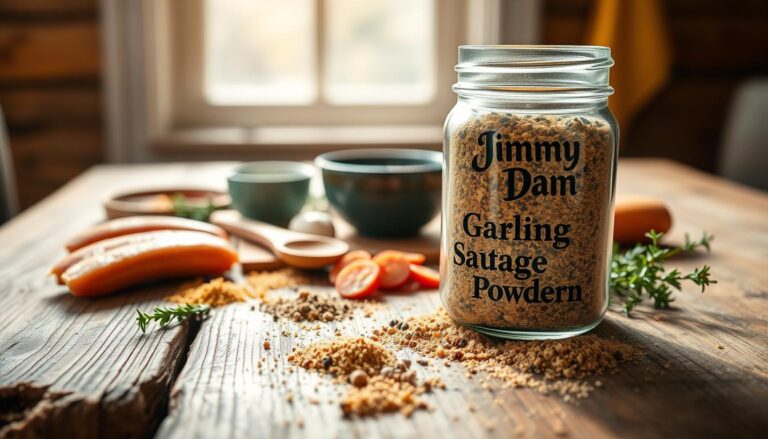Wake Up to Flavor: Authentic Arabic Breakfast Recipes You’ll Fall in Love With
Imagine starting your day with a breakfast table full of colors, smells, and tastes. Arabic breakfast recipes take your morning from ordinary to amazing. These dishes are more than food; they celebrate culture, tradition, and sharing.
Every bite has a story of generations. Ingredients like warm bread, creamy labneh, and fresh herbs make something magical. Arabic breakfast is about connection, family, and starting your day with delicious food.
From Beirut’s busy streets to Damascus’s quiet kitchens, these recipes hold centuries of wisdom. A mix of olives, herbs, and fresh bread can take you to the Middle East. It changes your breakfast forever.
Table of Contents
Understanding the Rich Heritage of Arabic Morning Meals
Traditional arabic morning meals are more than just food. They celebrate culture, connection, and community. In Arab societies, breakfast is a special time for families and neighbors to come together.
The morning meal in Arabic culture is a slow and meaningful experience. Each bite shares stories of generations-old traditions. These traditions have been kept alive through time.
Cultural Significance of Breakfast Time
Syrian breakfast fare is key to understanding Arab communities. These morning gatherings do more than just feed people:
- Strengthening family bonds
- Sharing daily news and stories
- Maintaining social connections
- Practicing hospitality traditions
Regional Variations Across the Arab World
Arabic breakfast traditions vary greatly across regions. This is due to local ingredients, cultural influences, and history. From Morocco to the Gulf states, each area adds its own flavors and preparations to the morning meal.
Traditional Serving Customs
Serving breakfast is an art in Arabic culture. Meals are shared around a large table. Guests are welcomed warmly, with food showing generosity and respect.
“In Arabic culture, breakfast is not just a meal – it’s a celebration of life and connection.”
Essential Ingredients for Arabic Breakfast Food Recipes
Starting with arabic breakfast food recipes means knowing the key ingredients. These ingredients are the heart of lebanese breakfast cuisine. They make simple dishes into amazing meals.
Make sure you have these essential ingredients for a true Arabic breakfast:
- Fava Beans: The main ingredient in many breakfast dishes
- Extra Virgin Olive Oil: Smooth and perfect for drizzling
- Za’atar Spice Blend: A mix of herbs and sesame seeds
- Fresh Yogurt: Creamy and great for many recipes
- Farm-fresh Eggs: Essential for many dishes
Now, let’s look at what makes these ingredients special:
| Ingredient | Flavor Profile | Culinary Use |
|---|---|---|
| Fava Beans | Earthy, nutty | Base for Ful Medames, protein-rich |
| Olive Oil | Smooth, fruity | Cooking, dressing, dipping |
| Za’atar | Herbal, tangy | Seasoning, bread topping |
| Yogurt | Tangy, creamy | Dips, sauces, standalone |
Knowing these ingredients will make your arabic breakfast recipes stand out. Lebanese breakfast cuisine is all about quality and mixing these staples. This way, you can make delicious morning meals at home.
“The secret to a perfect Arabic breakfast lies in the quality of its ingredients.” – Middle Eastern Culinary Experts
The Art of Making Ful Medames
Explore the world of egyptian breakfast delicacies with ful medames. This dish is packed with protein and has been loved by families for ages. It’s a nutritious and tasty way to start your day.
Ful medames is more than a meal; it’s a cultural experience. It connects people through food. This dish turns simple fava beans into a rich, satisfying breakfast that energizes and comforts.
Selecting the Perfect Fava Beans
Choosing the right fava beans is key for a true egyptian breakfast delicacy. Look for these important traits:
- Dried beans with a uniform, deep brown color
- Smooth, unblemished surface
- Firm texture without cracks
- Organic or locally sourced varieties
Traditional Cooking Methods
Preparing ful medames needs patience and care. The traditional way cooks the beans slowly. This makes the dish creamy and tender, making it special.
- Soak beans overnight in cold water
- Drain and rinse thoroughly
- Simmer in a pot with water for 2-3 hours
- Mash gently to create a smooth texture
Regional Garnishing Styles
Every region has its own way of garnishing ful medames. Garnishing is an art that turns the basic dish into a culinary masterpiece. Common toppings include:
- Extra virgin olive oil
- Chopped fresh parsley
- Diced tomatoes
- Minced garlic
- Squeeze of lemon juice
- Cumin and salt to taste
Pro tip: Serve your ful medames with fresh Egyptian bread for an authentic breakfast experience!
Mastering the Perfect Manakish
Explore the world of lebanese breakfast cuisine with manakish. It’s a beloved arabic breakfast food recipe that turns simple ingredients into a masterpiece. This Levantine flatbread is more than breakfast – it’s a cultural journey that connects you to generations of cooks.
To make authentic manakish, start with the dough. You want it to be light and airy, turning crispy when baked. The key is spreading za’atar, a fragrant spice blend, generously over the dough.
- Select high-quality olive oil for authentic flavor
- Ensure your dough is soft and elastic
- Use fresh za’atar for maximum taste
- Bake at high temperature for crispy edges
Making manakish involves stretching the dough by hand, a skill passed down through generations. Your manakish should be thin yet substantial, capable of holding the rich za’atar mixture without becoming soggy. It might seem hard, but with practice, you’ll get it right in these arabic breakfast food recipes.
Manakish is often described as the Middle Eastern cousin of pizza – a street food that tells a story of culinary tradition.
When serving, cut your manakish into triangles. Pair it with fresh cucumber, tomatoes, and creamy labneh. Each bite takes you on a journey through Lebanon’s rich culinary landscape, making breakfast unforgettable.
Shakshuka: A North African Breakfast Delight
Explore the vibrant world of Tunisian breakfast delights with shakshuka. This dish brings North African cuisine to your morning. It turns simple ingredients into a masterpiece, taking you to Morocco and Tunisia’s bustling markets.
Shakshuka is more than a meal; it’s a cultural experience. It captures the heart of Moroccan breakfast specialties. This dish combines rich flavors and nutritious ingredients in one skillet.
Perfecting the Tomato Base
Creating a great shakshuka begins with a strong tomato base. Your base should include:
- Ripe, fresh tomatoes
- Extra virgin olive oil
- Sweet bell peppers
- Caramelized onions
- Fresh garlic
Egg Poaching Techniques
The art of poaching eggs in shakshuka is key. Crack eggs gently into small wells in the tomato sauce. Cook on low heat, covered, to set the eggs perfectly.
Signature Spice Combinations
| Spice | Flavor Profile | Quantity |
|---|---|---|
| Cumin | Earthy warmth | 1 tsp |
| Paprika | Smoky sweetness | 2 tsp |
| Cayenne Pepper | Spicy kick | 1/4 tsp |
Try different spices to make your shakshuka unique. Tunisian and Moroccan versions have slight differences. But, they both celebrate fresh ingredients and bold flavors.
Emirati Chebab: Sweet Morning Pancakes

Explore the world of emirati breakfasts with chebab, a sweet pancake that makes mornings special. These pancakes are a taste of the United Arab Emirates, with spices and a soft texture.
Chebab is different from regular pancakes. It starts with a special batter. This batter has saffron and cardamom, making the pancakes golden and full of flavor.
- Key ingredients include:
- Flour
- Yeast
- Saffron
- Cardamom
- Dates or date syrup
Making chebab takes time and skill. Let the batter rest to make the pancakes light and slightly tangy. Traditionally, they are served with:
- Drizzling with date syrup
- Topping with honey
- Serving alongside fresh butter
Chebab is perfect for any special day or a cozy weekend breakfast. It brings a taste of Emirati culture to your home. Its sweet and aromatic taste connects families through food.
Creating Authentic Labneh at Home
Labneh is a key part of middle eastern breakfast dishes. It’s creamy and tangy, making your morning special. This Lebanese breakfast staple is more than yogurt; it’s a tradition that connects you to Arabic cuisine.
Making labneh at home is easy. You need good yogurt and some basic tools. Soon, your kitchen will smell like this Middle Eastern favorite.
Straining Techniques for Perfect Consistency
- Use a fine-mesh cheesecloth or special yogurt strainer
- Hang the yogurt for 24-48 hours in a cool place
- Choose full-fat yogurt for the creamiest results
- Allow gravity to naturally drain excess liquid
Flavor Enhancement Options
Make your labneh amazing with these ideas:
- Drizzle with extra virgin olive oil
- Sprinkle za’atar spice blend
- Add crushed dried mint
- Garnish with fresh herbs
Storage Tips
| Storage Method | Duration | Best Practices |
|---|---|---|
| Refrigerated (Sealed Container) | 1-2 weeks | Keep submerged in olive oil |
| Rolled into Balls | Up to 1 month | Store in olive oil-filled jar |
“Labneh is not just a food, it’s a connection to generations of culinary tradition.” – Middle Eastern Food Expert
Your homemade labneh will be a breakfast hit. It brings Middle Eastern morning flavors to your table. Try different methods and enjoy the tasty outcomes!
Traditional Arabic Breakfast Beverages
Exploring arabic breakfast food recipes means learning about the rich beverage culture. Arabic drinks are more than just refreshments. They are a cherished cultural experience that makes your morning special.
Arabic coffee is a key part of morning traditions in the Arab world. It’s prepared with care and served with elaborate rituals. This shows hospitality and connection. The coffee is made in a dallah (traditional coffee pot) and served in small cups called finjaan.
“In Arab culture, coffee is not just a drink, it’s a sacred ritual of welcome and respect.”
Popular Arabic Morning Beverages
- Arabic Coffee (Qahwa)
- Sage Tea
- Mint Tea
- Cardamom-infused Beverages
Herbal Tea Varieties
| Beverage | Region of Origin | Key Characteristics |
|---|---|---|
| Sage Tea | Levantine Region | Earthy flavor, digestive benefits |
| Mint Tea | North African Countries | Refreshing, cooling properties |
| Cardamom Coffee | Gulf Region | Aromatic, warming spice blend |
These traditional drinks have health benefits. Sage tea helps with digestion, and mint tea cools you down. The way they’re prepared shows centuries of culinary expertise in arabic breakfast food recipes.
Adding these authentic drinks to your morning routine connects you with a rich cultural tradition. Each sip shares a story of hospitality, community, and the vibrant flavors of Middle Eastern breakfast dishes.
Essential Bread Varieties for Your Arabic Breakfast
Bread is the heart of Arabic breakfasts, making meals special. In Syria, bread is more than a side—it’s the main attraction. Knowing about Arabic breads can make your breakfast amazing.

There are many types of Arabic bread, each with its own taste and making method. Let’s look at the top ones you’ll find at Middle Eastern breakfasts.
Traditional Arabic Bread Types
- Khubz: A round, soft flatbread perfect for scooping
- Markook: Thin, unleavened bread similar to a wrap
- Pita: Pocket bread ideal for stuffing
Preparation Techniques
Making authentic khubz needs skill and patience. It’s baked in stone ovens for a special taste and texture. The dough is made from wheat flour, water, salt, and yeast, then stretched and baked hot.
Storage and Freshness
It’s important to keep your bread fresh for the best taste. Store it in airtight containers or plastic bags at room temperature. You can also freeze it for up to a month to keep it fresh longer.
| Bread Type | Room Temperature Storage | Freezer Storage |
|---|---|---|
| Khubz | 2-3 days | 1 month |
| Markook | 1-2 days | 3-4 weeks |
| Pita | 3-4 days | 1 month |
Serving Suggestions
Arabic bread is great with spreads and dips. Try warm khubz with hummus, labneh, or olive oil and za’atar for a real Syrian breakfast.
Arabic Morning Meal Table Settings
Creating an authentic Arabic breakfast is more than just food. The way you set the table is just as important. It turns a simple meal into a lively social event.
For an Arabic breakfast, use the mezze-style. This communal way makes everyone share and try different dishes. It makes the meal warm and fun.
- Use large, round trays as central serving platforms
- Arrange dishes in a circular pattern for easy sharing
- Include multiple small plates with diverse flavors
- Prioritize colorful presentation
Key items for a true table setting are:
- Copper or brass serving platters
- Decorative ceramic dishes
- Hand-embroidered table linens
- Traditional tea glasses
Your aim is to make the table setting welcoming. It should honor Arabic breakfast traditions. Remember, how you present your food is very important in Middle Eastern dining.
Preserving and Storing Arabic Breakfast Ingredients
Learning to keep ingredients fresh is key for making authentic Arabic breakfast dishes. Your dishes will be a hit when you store and care for the ingredients right.
There are several ways to keep Arabic breakfast staples fresh for longer:
- Store labneh in airtight containers with a thin layer of olive oil to prevent spoilage
- Keep za’atar spice blend in a cool, dark pantry to maintain its robust flavor
- Wrap fresh khubz bread in clean kitchen towels to retain moisture
- Use glass jars for pickling vegetables to preserve their crisp texture
Keeping ingredients in the fridge is important for their quality. Homemade items like pickled veggies and cheeses need the right temperature. Choose good storage containers that seal well to keep out moisture and air.
Tip for making great Middle Eastern breakfasts: Mark your stored items with when you made them. Most homemade items can last up to two weeks if stored right. Always check for spoilage before using, and remember, fresh ingredients make the best breakfasts.
“Proper storage transforms good ingredients into extraordinary meals” – Arabic Culinary Wisdom
Conclusion: Embracing the Arabic Breakfast Tradition
Exploring arabic breakfast food recipes is more than just cooking. It’s a journey through flavors and traditions. These meals are not just food; they’re a way to connect with others.
Trying out these recipes can change your breakfast. From ful medames to chebab pancakes, each dish has its own story. You’ll learn to appreciate the Arab world’s food culture more.
Arabic breakfasts are great for bringing people together. Imagine starting your day with fresh khubz, homemade labneh, and aromatic drinks. These meals encourage you to enjoy your morning more.
Your food journey is just starting. Arabic breakfast will add warmth and flavor to your mornings. It’s a chance to experience a new tradition that will excite your senses.

